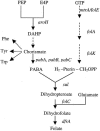Engineering of Bacillus subtilis for enhanced total synthesis of folic acid
- PMID: 16269750
- PMCID: PMC1287646
- DOI: 10.1128/AEM.71.11.7122-7129.2005
Engineering of Bacillus subtilis for enhanced total synthesis of folic acid
Abstract
We investigated whether the yield of the B vitamin folic acid could be elevated in Bacillus subtilis. Strategies for increasing the folic acid yield were investigated by employing computer-aided flux analysis and mutation. Controlling the activity of the enzyme pyruvate kinase by placing it under inducible control was one strategy devised to elevate yield while insuring that a rapid growth rate results. Other single mutation strategies included amplifying the expression of the genes in the folate operon and overexpressing the Escherichia coli aroH gene, which encodes 2-dehydro-3-deoxyphosphoheptonate aldolase. The latter could conceivably elevate the abundance of the folic acid precursor, para-aminobenzoic acid. Strains that combined two or more mutations were also constructed. Overall, a strain possessing inducible pyruvate kinase, overexpressed aroH, and increased transcription and translation of genes from the folic operon exhibited the best yield. The yield was eightfold higher than that displayed by the parent B. subtilis 168 strain.
Figures





Similar articles
-
An apparent Bacillus subtilis folic acid biosynthetic operon containing pab, an amphibolic trpG gene, a third gene required for synthesis of para-aminobenzoic acid, and the dihydropteroate synthase gene.J Bacteriol. 1990 Dec;172(12):7211-26. doi: 10.1128/jb.172.12.7211-7226.1990. J Bacteriol. 1990. PMID: 2123867 Free PMC article.
-
The mtrAB operon of Bacillus subtilis encodes GTP cyclohydrolase I (MtrA), an enzyme involved in folic acid biosynthesis, and MtrB, a regulator of tryptophan biosynthesis.J Bacteriol. 1992 Apr;174(7):2059-64. doi: 10.1128/jb.174.7.2059-2064.1992. J Bacteriol. 1992. PMID: 1551827 Free PMC article.
-
[Synthesis of recombinant proteins under the control of regulatory elements of Lac operon].Antibiot Khimioter. 1991 Dec;36(12):27-33. Antibiot Khimioter. 1991. PMID: 1814271 Review. Russian. No abstract available.
-
[Anaerobic synthesis of succinic acid by Escherichia coli strains with activated NAD+ reducing pyruvate dehydrogenase complex].Prikl Biokhim Mikrobiol. 2011 Jul-Aug;47(4):415-23. Prikl Biokhim Mikrobiol. 2011. PMID: 21950115 Russian.
-
[PO-independent termination of transcription of catabolite operons in Escherichia coli and Bacillus subtilis].Mol Gen Mikrobiol Virusol. 1999;(3):3-7. Mol Gen Mikrobiol Virusol. 1999. PMID: 10495975 Review. Russian.
Cited by
-
The structure of a tetrahydrofolate-sensing riboswitch reveals two ligand binding sites in a single aptamer.Structure. 2011 Oct 12;19(10):1413-23. doi: 10.1016/j.str.2011.06.019. Epub 2011 Sep 8. Structure. 2011. PMID: 21906956 Free PMC article.
-
Factors affecting plasmid production in Escherichia coli from a resource allocation standpoint.Microb Cell Fact. 2009 May 22;8:27. doi: 10.1186/1475-2859-8-27. Microb Cell Fact. 2009. PMID: 19463175 Free PMC article.
-
Biological, dietetic and pharmacological properties of vitamin B9.NPJ Sci Food. 2025 Mar 13;9(1):30. doi: 10.1038/s41538-025-00396-w. NPJ Sci Food. 2025. PMID: 40075081 Free PMC article. Review.
-
'Unknown' proteins and 'orphan' enzymes: the missing half of the engineering parts list--and how to find it.Biochem J. 2009 Dec 14;425(1):1-11. doi: 10.1042/BJ20091328. Biochem J. 2009. PMID: 20001958 Free PMC article. Review.
-
The folate precursor para-aminobenzoic acid elicits induced resistance against Cucumber mosaic virus and Xanthomonas axonopodis.Ann Bot. 2013 May;111(5):925-34. doi: 10.1093/aob/mct049. Epub 2013 Mar 7. Ann Bot. 2013. PMID: 23471007 Free PMC article.
References
-
- Chen, R., V. Hatzimanikatis, W. Yap, P. W. Postma, and J. E. Bailey. 1997. Metabolic consequences of phosphotransferase (PTS) mutation in a phenylalanine-producing recombinant Escherichia coli. Biotechnol. Prog. 13:768-775. - PubMed
-
- de Saizieu, A., P. Vankan, C. Vockler, and A. P. van Loon. 1997. The trp RNA-binding attenuation protein (TRAP) regulates the steady-state levels of transcripts of the Bacillus subtilis folate operon. Microbiology 143:979-989. - PubMed
Publication types
MeSH terms
Substances
LinkOut - more resources
Full Text Sources
Other Literature Sources
Medical

